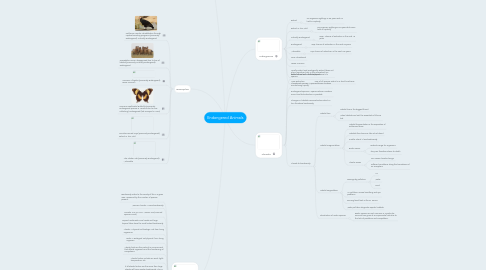
1. Examples
1.1. California Condor, rehabilitation through captive breeding programs (previously Endangered): Critically Endangered
1.2. Przewalski’s Horse, disappeared due to loss of habitat (previously Critically Endangered): Endangered
1.3. American Alligator (previously Endangered): Lower Concern
1.4. Homerus Swallowtail Butterfly (previously Endangered species in Jamaica due to over collecting): Endangered (last surveyed in 1996)
1.5. Scimitar-Horned Oryx (previously Endangered): Extinct in The Wild
1.6. The Tibetan Yak (previously Endangered): Vulnerable
2. Biodiversity
2.1. Biodiversity refers to the variety of life in a given area, measured by the number of species present.
2.2. Warmer climate = more biodiversity
2.3. Canada 163, US, 367, Mexico 439 (mammal species count)
2.4. Tropical rainforests, coral reeds and large tropical lakes have the most/richest biodiversity
2.5. Abiotic = Physical not biologic, not from living organisms
2.6. Biotic = Biological not physical, from living organism
2.7. Abiotic facts are the parts of an environment that effects organisms and the functioning of ecosystems
2.8. Abiotic factors include air, wind, light, temperature, etc.
2.9. If all abiotic factors are the same then large islands will have greater biodiversity. This is because there are different types of environments within the ecosystem which allows for a richer biodiversity.
2.10. A smaller island that is in a warmer climate than a larger island will most likely have a greater biodiversity.
2.11. Benifits
2.11.1. Biodiversity adds beauty to nature.
2.11.2. Breaking the food chain will result in devastating effects on a community.
2.11.3. Life depends on life: A change in one population will result in a change on another population
2.11.4. Biodiversity brings stability
2.11.5. Biodiversity gives humans
2.11.5.1. Oxygen
2.11.5.2. CO2 Reduction
2.11.5.3. Variety in diet
2.11.5.4. Cloth production
2.11.5.5. Increase in crop production
2.11.5.6. Medicine
3. Biological Conservation
3.1. Conservation biology protects biodiversity
3.2. Species conservation
3.3. Resource conservation
3.4. Preserving habitats:
3.4.1. A habitat is a place where an organism lives for its entire life
3.4.2. Protecting a whole community is done by setting ip nature preserves or national parks
3.4.3. Habitat corridors are protected strips of land that allow for the migration of organisms from one land area to another
3.5. Reintroduction programs
3.5.1. Involves moving organisms to another location to boost population and then moving them back to the original location
3.5.2. Reintroduction programs are the most successful when in a natural habitat
4. Categories
4.1. Extinct
4.1.1. No organism sightings in 50 years and no held in captivity
4.2. Extinct In The Wild
4.2.1. No organism sightings in 50 years but some held in captivity
4.3. Critically Endangered
4.3.1. 50%+ chance of extinction in the next 10 years
4.4. Endangered
4.4.1. 20% chance of extinction in the next 20 years
4.5. Vulnerable
4.5.1. 10% chance of extinction in the next 100 years
4.6. Near Threatened
4.7. Lesser Concern
4.8. Locally Extinct and Ecologically Extinct (does not play a significant role in the ecosystem) are lesser known and unofficial terms.
4.9. Mass Extinction
4.9.1. 40% of all species extinct in a short timeframe
5. Threats
5.1. Extinction refers to the disappearance of a species
5.2. Threatened species = species whose numbers are declining rapidly
5.3. Endangered species = species whose numbers are so low that extinction is possible
5.4. Changes in habitats cause extinction which in turn threatens biodiversity
5.5. Threats to biodiversity
5.5.1. Habitat loss
5.5.1.1. Habitat loss is the biggest threat
5.5.1.2. When habitats are lost, the essentials of life are lost
5.5.2. Habitat Fragmentation
5.5.2.1. Habitat fragmentation is the separation of wilderness areas
5.5.2.2. Habitats then become like virtual island
5.5.2.3. Smaller island = less biodiversity
5.5.2.4. Biotic Issues:
5.5.2.4.1. Restricts range for organisms
5.5.2.4.2. They can therefore starve to death
5.5.2.5. Abiotic Issues
5.5.2.5.1. Can cause climate change
5.5.2.5.2. Different conditions along the boundaries of an ecosystem
5.5.3. Habitat Degradation
5.5.3.1. Damage by pollution:
5.5.3.1.1. Air
5.5.3.1.2. Water
5.5.3.1.3. Land
5.5.3.2. Air pollution causes breathing and eye problems
5.5.3.3. Burning fossil fuels is the #1 source
5.5.3.4. Water pollution degrades aquatic habitats
5.5.4. Introduction of exotic species
5.5.4.1. Exotic species are not common in a particular area and can grow at an exponential rate due to the lack of predators and competitors.

